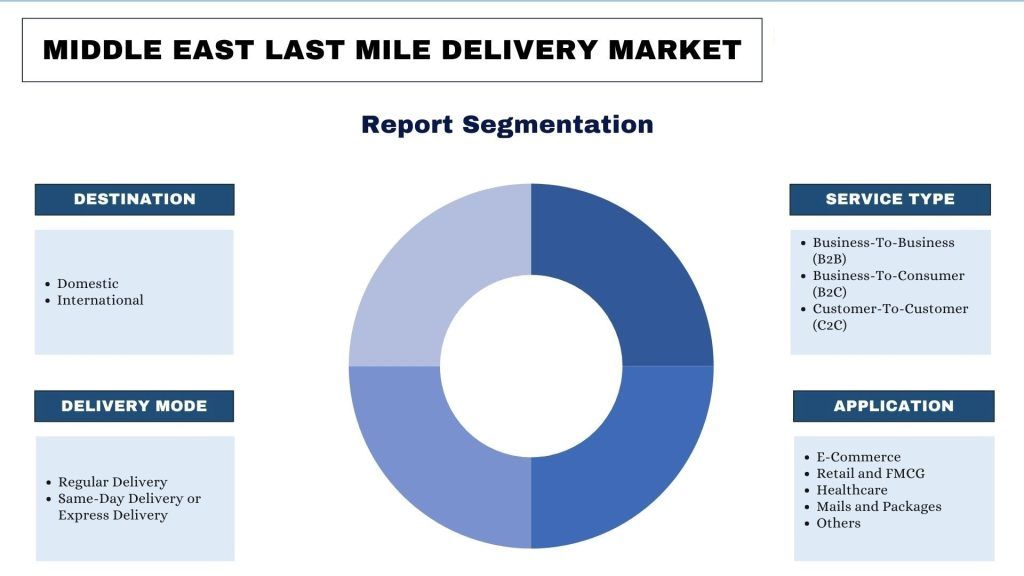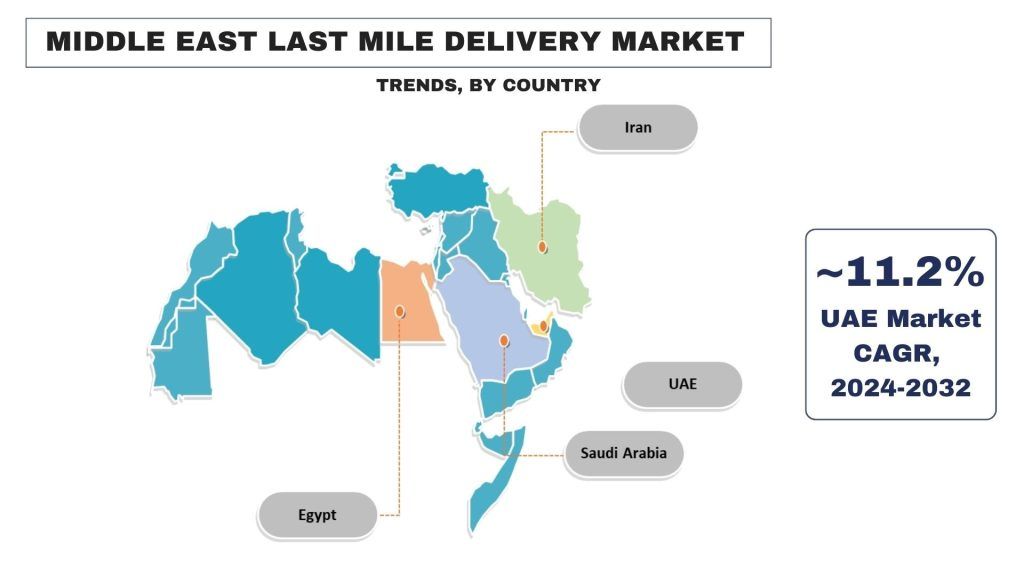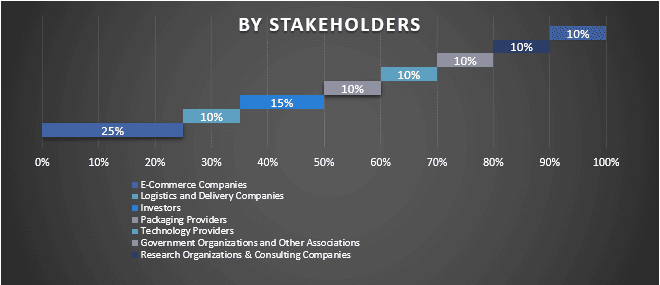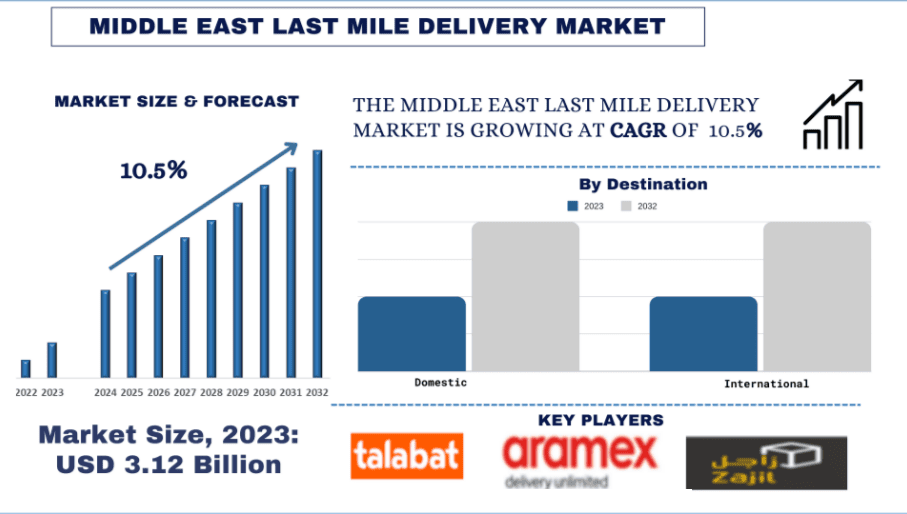中東地區最後一哩路配送市場:現況分析與預測 (2024-2032)
目的地導向 (國內及國際);服務類型 (企業對企業 (B2B)、企業對消費者 (B2C) 及客戶對客戶 (C2C));運送方式 (一般運送及當日送達或快遞);應用 (電子商務、零售及快速消費品 (FMCG)、醫療保健、郵件及包裹,以及其他);車輛類型 (機車、輕型商用車 (LCV)、重型商用車 (HCV) 及無人機);操作模式 (非自主及自主);國家。
中東最後一哩路送貨市場規模與預測
中東最後一哩路送貨市場在 2023 年的估值為 31.2 億美元,預計在預測期間 (2024-2032 年) 將以約 10.5% 的強勁複合年增長率增長。
中東最後一哩路送貨市場分析
最後一哩路送貨是送貨流程的最後階段,貨物從配送中心或樞紐運輸到最終目的地,通常是住宅或商業地址。之所以稱為「最後一哩路」,是因為它代表了送貨旅程的最後一程,通常也是最具挑戰性的一程。這個階段至關重要,因為它直接影響客戶滿意度,並且可能是供應鏈中最昂貴和最耗時的部分。最後一哩路送貨在電子商務中至關重要,因為客戶期望快速且可靠地交付他們的線上購買商品。
由於政府支持力道不斷增加,中東最後一哩路送貨市場預計在預測期間將以 10.5% 的強勁複合年增長率增長。例如,在沙烏地阿拉伯,政府啟動了「2030 年願景」等倡議,旨在使經濟多元化並促進電子商務產業的發展。這些倡議包括對基礎設施發展的投資,例如改善道路網絡和實施智慧城市技術,預計這些將推動該地區最後一哩路送貨市場的增長。此外,中東各國政府正在推出法規以支持電子商務產業,預計這將進一步提高對最後一哩路送貨服務的需求。

中東最後一哩路送貨市場區隔
根據目的地,中東最後一哩路送貨市場分為國內和國際。國內區隔在 2023 年佔據了市場的主導份額。這種主導地位可歸因於該地區線上購物的日益普及,這是由於網路普及率不斷提高以及電子商務平台提供的便利性所推動的。例如,阿拉伯聯合大公國和沙烏地阿拉伯等國家的線上購物活動顯著增加,導致對國內最後一哩路送貨服務的需求增加。
按服務類型劃分,中東最後一哩路送貨市場分為企業對企業 (B2B)、企業對消費者 (B2C) 和客戶對客戶 (C2C)。企業對消費者 (B2C) 區隔在 2023 年佔據了市場的主導份額。這可歸因於迎合個別消費者的電子商務平台的興起,這增加了 B2C 送貨的數量。此外,線上購物的便利性以及多種送貨方式的可用性,也促進了中東 B2C 最後一哩路送貨市場的增長。
根據送貨方式,中東最後一哩路送貨市場分為常規送貨和當日送貨或快遞送貨。常規送貨區隔在 2023 年佔據了市場的主導份額。這可歸因於常規送貨服務更為常用,並且通常對企業和消費者而言更具成本效益。然而,隨著對更快送貨時間的需求不斷增加,預計當日送貨區隔將在未來幾年迅速擴張。
按應用劃分,中東最後一哩路送貨市場分為電子商務、零售和快速消費品、醫療保健、郵件和包裹以及其他。電子商務區隔在 2023 年佔據了市場的主導份額。這可歸因於該地區電子商務產業的快速增長,這是由於智慧型手機普及率不斷提高、可支配收入增加以及線上購物的便利性等因素所推動的。電子商務公司越來越注重改善其最後一哩路送貨服務,以滿足客戶期望並在市場中獲得競爭優勢。
沙烏地阿拉伯在 2023 年佔據了市場的主導份額
沙烏地阿拉伯在 2023 年佔據了市場的主導份額。這種主導地位可歸因於多個因素,包括該國龐大的人口、高網路普及率以及政府對電子商務產業的強有力支持。例如,沙烏地阿拉伯的「2030 年願景」倡議旨在轉變該國的經濟和社會,重點是加強電子商務生態系統。因此,沙烏地阿拉伯在基礎設施發展方面進行了大量投資,例如新的道路和物流樞紐,這有助於該國最後一哩路送貨市場的增長。此外,沙烏地阿拉伯對線上購物的需求不斷增長,以及越來越多的電子商務業者,進一步推動了該國最後一哩路送貨產業的發展。

中東最後一哩路送貨產業概覽
中東最後一哩路送貨市場具有競爭力且分散,存在多家區域和國際市場參與者。主要參與者正在採取不同的增長策略來提高其市場佔有率,例如夥伴關係、協議、合作、新產品發布、地域擴張以及併購。在市場上運營的一些主要參與者包括 Aramex、Fetchr、Talabat、Zajil Express、HungerStation、Marsool、Tawseel、Wadi、Carriage 和 Mrsool。
中東最後一哩路送貨市場新聞
- 2019 年,Aramex 推出了 Aramex Spot,這是一個新的服務點網絡,旨在透過為客戶提供更方便的取貨和送貨地點來加強最後一哩路送貨解決方案。
中東最後一哩路送貨市場報告涵蓋範圍
報告屬性 | 詳細資訊 |
基準年 | 2023 |
預測期間 | 2024-2032 |
增長動能 | 以 10.5% 的複合年增長率加速增長 |
2023 年市場規模 | 31.2 億美元 |
主要貢獻地區 | 預計沙烏地阿拉伯在預測期間將以最高的複合年增長率增長 |
涵蓋的關鍵國家 | 阿拉伯聯合大公國、沙烏地阿拉伯、埃及、伊朗、中東其他地區 |
已分析的公司 | Aramex、Fetchr、Talabat、Zajil Express、HungerStation、Marsool、Tawseel、Wadi、Carriage 和 Mrsool。 |
報告範圍 | 市場趨勢、驅動因素和限制;收入估算和預測;區隔分析;需求和供應端分析;競爭格局;公司分析 |
涵蓋的區隔 | 按目的地;按服務類型;按送貨方式;按應用;按車輛類型;按運營模式;按地區/國家 |
購買此報告的原因:
- 該研究包括經認證的關鍵行業專家驗證的市場規模和預測分析。
- 該報告快速回顧了整個行業的績效。
- 該報告涵蓋了對主要行業同行的深入分析,主要側重於關鍵業務財務、產品組合、擴張策略和最新發展。
- 詳細檢查了行業中普遍存在的驅動因素、限制、關鍵趨勢和機會。
- 該研究全面涵蓋了跨不同區隔的市場。
- 對行業進行深入的區域層面分析。
客製化選項:
中東最後一哩路送貨市場可以根據要求或任何其他市場區隔進一步客製化。除此之外,UMI 明白您可能有自己的業務需求,因此請隨時與我們聯繫以取得完全符合您需求的報告。
目錄
中東最後一哩路交付市場分析(2024-2032 年)的研究方法
分析歷史市場、估計當前市場以及預測中東最後一哩路交付市場的未來市場,是創建和分析主要國家中東最後一哩路交付採用情況的三個主要步驟。進行了詳盡的二級研究,以收集歷史市場數據並估計當前市場規模。其次,為了驗證這些見解,我們考慮了許多發現和假設。此外,還與中東最後一哩路交付市場價值鏈中的行業專家進行了詳盡的初步訪談。在透過初步訪談假設和驗證市場數據後,我們採用由上而下/由下而上的方法來預測完整的市場規模。此後,採用市場細分和資料三角測量方法來估計和分析與產業相關的區隔和子區隔的市場規模。詳細方法如下所述:
歷史市場規模分析
步驟 1:深入研究二級來源:
我們進行了詳細的二級研究,透過公司內部來源(例如年度報告和財務報表、績效簡報、新聞稿等)以及外部來源(包括期刊、新聞與文章、政府出版物、競爭對手出版物、產業報告、協力廠商資料庫和其他可靠的出版物)來獲取中東最後一哩路交付市場的歷史市場規模。
步驟 2:市場區隔:
在獲得中東最後一哩路交付市場的歷史市場規模後,我們進行了詳細的二級分析,以收集主要地區不同區隔和子區隔的歷史市場見解和份額。報告中包含的主要區隔包括目的地、服務類型、交付模式、應用、車輛類型、運作模式。此外,還進行了國家級分析,以評估整體採用情況。
步驟 3:因素分析:
在獲得不同區隔和子區隔的歷史市場規模後,我們進行了詳細的因素分析,以估計中東最後一哩路交付市場的當前市場規模。此外,我們使用中東最後一哩路交付市場的目的地、服務類型、交付模式、應用、車輛類型、運作模式等依存變數和獨立變數進行了因素分析。我們針對需求和供應端情境進行了全面分析,考慮了中東最後一哩路交付市場中的頂級合作夥伴關係、併購、業務擴張和產品發布。
當前市場規模估計與預測
當前市場規模:根據以上 3 個步驟的可行見解,我們得出了當前市場規模、中東最後一哩路交付市場中的主要參與者以及區隔的市場份額。所有必需的百分比份額拆分和市場細分均使用上述二級方法確定,並透過初步訪談進行驗證。
估計與預測:對於市場估計和預測,我們為不同的因素分配了權重,包括利害關係者的驅動因素和趨勢、限制和機會。在分析這些因素後,我們應用了相關的預測技術,即由上而下/由下而上的方法,以得出 2032 年主要市場不同區隔和子區隔的市場預測。用於估計市場規模的研究方法包括:
- 該產業的市場規模,以收入(美元)以及國內主要市場中東最後一哩路交付市場的採用率表示
- 市場區隔和子區隔的所有百分比份額、拆分和細分
- 中東最後一哩路交付市場中按提供的產品劃分的主要參與者。此外,這些參與者為在快速成長的市場中競爭而採用的成長策略
市場規模與份額驗證
初步研究:我們與主要地區的關鍵意見領袖 (KOL)(包括高層主管(CXO/VP、銷售主管、行銷主管、營運主管、區域主管、國家主管等))進行了深入訪談。然後總結初步研究結果,並進行統計分析以驗證既定假設。來自初步研究的意見與二級研究結果相結合,從而將資訊轉化為可行的見解。
主要參與者拆分

市場工程
我們採用資料三角測量技術來完成整體市場估計,並得出中東最後一哩路交付市場各個區隔和子區隔的精確統計數據。在研究了中東最後一哩路交付市場的目的地、服務類型、交付模式、應用、車輛類型、運作模式等領域的各種參數和趨勢後,資料被拆分為多個區隔和子區隔。
中東最後一哩路交付市場研究的主要目標
研究中指出了中東最後一哩路交付市場當前和未來的市場趨勢。投資者可以獲得策略性見解,以根據研究中執行的定性和定量分析來決定投資。當前和未來的市場趨勢決定了國家層面市場的整體吸引力,為產業參與者提供了一個利用尚未開發的市場從先發優勢中受益的平台。研究的其他定量目標包括:
- 分析中東最後一哩路交付市場當前和預測的市場規模(以價值(美元)計算)。此外,分析不同區隔和子區隔的當前和預測的市場規模。
- 研究中的區隔包括目的地、服務類型、交付模式、應用、車輛類型、運作模式等領域。
- 定義和分析中東最後一哩路交付的監管架構
- 分析與各種中介機構的存在相關的價值鏈,以及分析該產業的客戶和競爭對手的行為。
- 分析主要國家中東最後一哩路交付市場當前和預測的市場規模。
- 中東最後一哩路交付市場的公司概況以及市場參與者為在快速成長的市場中維持而採用的成長策略
- 深入分析該產業的國家級分析
常見問題 常見問題
Q1:中東地區最後一哩路配送市場目前的市場規模和成長潛力為何?
Q2:中東最後一哩路送貨市場增長的驅動因素有哪些?
Q3:哪個目的地分部在中東最後一英里派送市場佔有最大的份額?
Q4:中東地區最後一哩路配送市場的新興技術和趨勢是什麼?
Q5:哪個國家將主導中東地區的最後一哩路配送市場?
相關 報告
購買此商品的客戶也購買了











